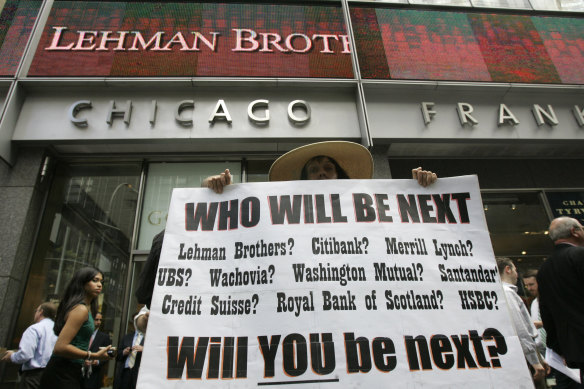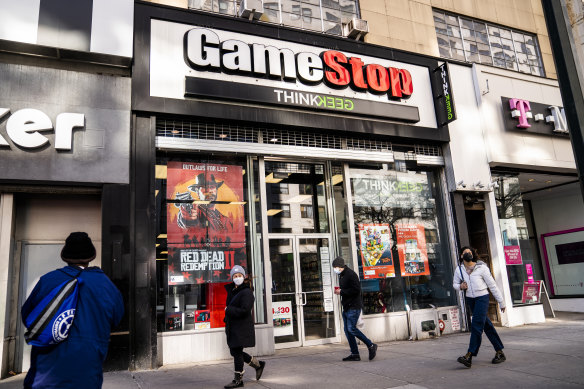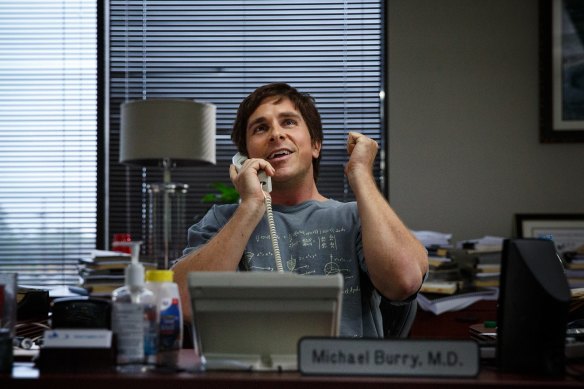Explainer
- Explainer
- Investing
From Gosling to GameStop, ‘shorting’ is having a moment. But what exactly is it?
Huge risks and high stakes make this investment strategy edgy. How does short-selling work?
By Millie Muroi
Shorting someone of change is pretty clearly a bad thing – but what about “shorting” a company?
When US investor Michael Burry shot to fame after the global financial crisis, it was because he’d made hundreds of millions of dollars while people lost their homes and businesses collapsed – all through a quirk of investing that allows you to bet against someone or something’s success.
It’s called short-selling.
Burry’s financial success inspired a film, The Big Short, in which he was depicted by Christian Bale. The film also starred Ryan Gosling as a credit derivatives (we will get to that later) salesman. “You smell that? What is that?” asks Gosling’s character in one scene. “I smell money.”
Jared Vennett (Ryan Gosling) explains credit default swaps in The Big Short.Credit: Paramount Pictures
Short-selling has been making news in the real world, too. In the GameStop “short squeeze” of 2021, users of the online chat forum Reddit triggered huge losses for major fund managers who were shorting the video game retailer; more recently in May, a short squeeze put pressure on the London Metals Exchange to suspend and cancel trades of a major commodity, nickel.
With local and global sharemarkets under serious pressure amid fears of a recession, many retail investors are considering adopting short-selling for the first time.
Matt Leibowitz, chief executive of low-cost share trading platform Stake says he has seen a significant increase in people looking to short over the past year, as the value of high profile tech stocks starting falling. But the growing awareness of short-selling among individual investors is a trend that is a decade in the making, he says.
“I actually think it’s cultural,” he says. “You have [films such as] The Big Short and Billions so there’s more awareness, and there’s been a rise in general education about the fact that institutions have been doing this for decades.”
So, what exactly is shorting? What makes it edgy? And could you try it if you wanted to?

Margot Robbie plays herself in The Big Short explaining mortgage-backed bonds in a bath of bubbles.
What’s shorting?
It’s worth noting at this point that short-selling is a highly risky trading strategy. When you buy shares, the potential losses are limited to what you paid for them. When you short them, and if the trade goes against you, you can lose much, much more than your initial outlay.
For most people, investing is about putting your money into something you think will be worth more in the future; maybe a house, cryptocurrency or a part of a company you think is going to keep growing.
Basically, you’re buying an “asset” (something that holds value) that you think you’ll make money from if you hold on to it for some time. This is called holding a “long” position.
You might sell it later and make a profit because it’s become more valuable. Or, you might hold on to the asset, hoping it keeps climbing in value, or because you get a good payout from it every so often (a dividend or interest).
But what if you think an asset is headed for the rocks?
That’s when you might bet against, or “short” it. Short-selling is selling something you don’t own in order to make a profit. You make money if the value of what you’re shorting falls.
And how do you make money from something going badly?
First, let’s say you think an investment, such as shares in Company X, is a bit overrated. The company is struggling, and their shares are probably going to be worth a lot less in a week’s time, you think. Instead of buying and holding on to shares, you can borrow Company X shares from a friend and promise to give them back to them by a certain date. The sweetener for the friend is that you also pay a small fee to borrow the stock.
Then, you immediately sell the shares to someone else. Say one share was worth $10. You now have $10 (a bit less if you deduct the fee you paid to your friend). Your “friend” and the “someone else”, in the real world are other traders or investors willing to trade with you, typically anonymously, through an exchange or platform.
Now you wait, fingers crossed, for the value of Company X’s shares to fall.
The risk for you, as the short-seller, is that you’re wrong about an asset being over-rated. If you get it wrong, your losses are theoretically limitless.
A week later, hallelujah! Company X’s share price has fallen to $5. So, you find one of their shares on the market and buy it. You “return” that share to your friend (it’s now worth less in dollar terms but it’s still what you promised them). That’s called closing your position.
You don’t have any Company X shares any more. But you’ve just made $5 (minus the small fee you paid to borrow it from your friend) without ever actually owning the shares. Ker-ching!
What’s in it for the person you’re borrowing the shares from? Well, they’re probably holding on to the asset for the long term because they think it will increase in value over time. By lending the shares out and receiving a fee they receive some passive income without really doing anything.
The risk for you, as the short-seller, is that you’re wrong about an asset being over-rated. If you get it wrong, your losses are theoretically limitless. Why? Because if you’ve promised to give your friend back their Company X share in a week, sold it and during that week the value of Company X shares skyrocket, you still have to keep your promise. You still have to buy a Company X share to give back to your friend, even if each one is now worth a whopping $20 (or $40, or $10,000 …) Having initially sold them when they were worth $10, you’re now having to dig for an additional $10 (or $30, or $9990 ...) from your own pocket.
This is why shorting is a risky business.
A legendary example of shorting is US investor George Soros’s £10 billion bet against the British pound in 1992. Soros bet that Britain couldn’t keep its currency within the exchange rate range required by the European Exchange Rate Mechanism (ERM), which was supposed to be a step towards ditching the pound for the euro. The UK government exhausted its reserves trying to prop up the value of the pound relative to other currencies and eventually gave up. Soros made a fortune as the pound came crashing down, and the UK was forced to withdraw their currency from the ERM.
Another famous example was Burry’s Big Short against the US housing market. As depicted in the movie, Burry figured out before almost anyone else that the boom in US house prices at the time was unsustainable, and ultimately built on risky “subprime” mortgages that banks allowed people who couldn’t afford them to obtain.
But Burry didn’t short bank shares or homebuilding stocks. Instead he bought derivatives from Gosling’s character that would pay off if those mortgages went sour.
While there’s the belief that shorting brought about the global financial crisis, it was actually caused by a cocktail of factors including banks making risky loans (some argue that bankers knew what was going on but didn’t intervene because they received bonuses from having all these loans issued), credit agencies incorrectly labelling instruments, and the eventual panic of investors pulling their money out of banks and investment funds when things started looking bad.
Short-sellers such as Burry foresaw the collapse and made money by betting against something that too many investors had too much confidence in.

Lehman Brothers was the first bank to collapse in the global financial crisis.Credit: AP
What’s naked shorting?
In Australia, it’s legal to engage in shorting of shares as long you have an agreement in place that guarantees you’ll have the assets you’re intending to sell – and the right to give your buyer title over the product – when you go to sell them. That’s called “covered short selling”.
On the other hand, “naked short selling” is where you offer to sell assets that you neither own nor have an agreement in place to get by the time you need to sell them. This is generally illegal, except in limited circumstances determined by ASIC.
Following the global financial crisis, the Securities and Exchange Commission banned naked short selling in the United States. Other international exchanges, including the Tokyo Stock Exchange, and several European regulators have also banned the practice at various times, including in Great Britain in 1733 after the South Sea Bubble burst.

This was not a movie: a short squeeze led by retail investors caused GameStop’s share price to skyrocket in 2021.Credit: AP
What’s a short squeeze?
A short squeeze is really unpleasant for short sellers.
Basically, it’s when a heavily short-sold asset skyrockets in value. That can happen when short-seller’s bearish predictions are simply wrong – for example, if a company they are betting against releases financial results or forecasts that are stronger than expected. Or, it can happen if an investor, or group of investors knows someone is short an asset, and tries to “squeeze” them out of their position by buying up the asset.
Remember, if you’ve shorted something, you have to buy it back eventually to return it to whomever you borrowed it from. That’s called closing your position.
If you’ve shorted an asset but there’s suddenly positive news about it, you’re going to want to get out of your short position pretty quick. But all the other short-sellers are probably thinking the same thing.
If they all rush to try and buy the asset at the same time, the value of it goes through the roof. And the longer you wait, the worse your losses might get.
In the GameStop saga, a group of day traders on Reddit banded together to buy shares in the video game retailer, knowing that the hedge funds who had shorted the stock on a view the company’s fortunes were grim would be forced to capitulate.
(What made the GameStop saga so remarkable was the ability of retail traders to wreak havoc on professional investment funds’ trading strategies. And when the squeeze took place and GameStop shares skyrocketed, the company was not performing very well).

Christian Bale in The Big Short.Credit: AP
So, can anyone try shorting?
Historically, short selling has been pursued by professional investment firms such as hedge funds and investment banks. Burry, for example, was a professional investor, acting on behalf of his hedge fund. But as Stake’s Leibowitz earlier noted, retail investors are increasingly keen to get in on the act.
Most retail brokers in Australia don’t actually allow for short-selling as outlined above. But there are still ways for individual investors to get exposure to the strategy. Arguably the easiest way is to invest money in managed funds that take short positions. There are short-themed exchange traded funds on the US sharemarket and the ASX.
Most retail brokers in Australia don’t actually allow for short-selling as outlined above ... Many brokers do allow retail traders to take out derivative contracts that give them exposure to short positions.
Many brokers do allow retail traders to take out derivative contracts that give them exposure to short positions. These include contracts for difference, or CFDs, which allow users to speculate on the price of shares, commodities and currencies without ever owning the underlying asset. ASIC has repeatedly warned about CFDs and last year capped the amount of leverage retail investors can use in them.
The other derivatives available to retail investors are futures contracts and options, which are both traded on the ASX.
Here is an example of how a futures contract works. Maybe the price of fuel this week is $2 a litre. You think the price will plummet to $1 a litre by next Wednesday. So, you buy a future contract on a litre of fuel from a shipping company. You’ll sell the litre of fuel to them for exactly $2 on Wednesday next week.
The shipping company agrees because they’re worried the price of fuel is headed up to $3. It’s a great deal for them if the price of fuel does increase by Wednesday because it means they get to buy a litre of fuel from you for $2 instead of the $3 it’s going for on the market.
If, however, the price of fuel decreases to $1 a litre as you’ve predicted, the shipping company loses out because they now have to buy the fuel from you, even though it’s more expensive than it would have been without the contract. But good news for you because you’ve just made $1.

A scene from The Big Short.Credit: Paramount Pictures
But hang on, would you want to be making these deals?
Profiting from someone else’s misfortune sounds mean, but advocates of shorting say the strategy helps the market operate more efficiently. Short-sellers can stop bubbles forming (and bursting) by keeping in check the excessive optimism that inflates bubbles with any negative information they might unearth about an investment.
The most common argument in favour of shorting is that it provides market liquidity, according to University of Sydney professor of corporate law Jason Harris. Market liquidity refers to how much volume and how easily people are able to buy and sell assets at stable and visible prices. “Having a market where there are a lot of buyers and sellers, and lots of transactions, makes investors more confident that they’re going to be able to allocate their money as they see fit,” says Harris. “Why would I buy shares if I think no one is ever going to want to buy the securities from me in the future or reallocate my money somewhere else?”
A more liquid market also makes companies more confident they’ll be able to raise money because they know that if they issue shares, they’re likely to have investors who are interested.
Still, the perception of short-sellers being vultures and driving companies into failure through shorting has some truth to it. It depends on how it’s done.
Short-sellers often point out that investors who hold long positions can also distort a company’s value by talking it up.
Since they want to see the price of an asset fall, some short-sellers release false or incomplete information, or use overly emotive language to manipulate how other investors see the asset. This is called a “short and distort” strategy. “We can end up in circumstances where certain investors are playing games with a company’s shares that really have very little to do with their fundamental value,” Harris says.
In 2019, Beijing-based short-seller J Capital Research released a report that claimed Australian tech company WiseTech’s strategy was failing. Within 33 minutes of the report dropping, the price of WiseTech’s shares fell by more than $1.3 billion. J Capital also claimed that WiseTech was overstating its profits and using accounting tricks to cover its track. At the time, even a Morningstar analyst who thought WiseTech was dramatically overvalued found J Capital’s arguments unconvincing. By November 2021, WiseTech shares were up 420 per cent and allegations of fraud had been all but dismissed.
Short-sellers often point out that investors who hold long positions can also distort a company’s value by talking it up.
The other argument against shorting is that it can drive companies that are not performing well, but not failing, into liquidation.
There have been some calls for increased regulation of shorting, including limiting the timeframe in which reports can be released by short-sellers to when markets are closed so that companies have time to respond. There have also been demands for short-selling to be banned outright.
But short-sellers have also helped to expose corporate scandals at companies such as US commodities firm Enron and ASX-listed investment firm BlueSky through bringing information to light.
Fascinating answers to perplexing questions delivered to your inbox every week. Sign up to get our new Explainer newsletter here.
Let us explain
If you'd like some expert background on an issue or a news event, drop us a line at explainers@smh.com.au or explainers@theage.com.au. Read more explainers here.